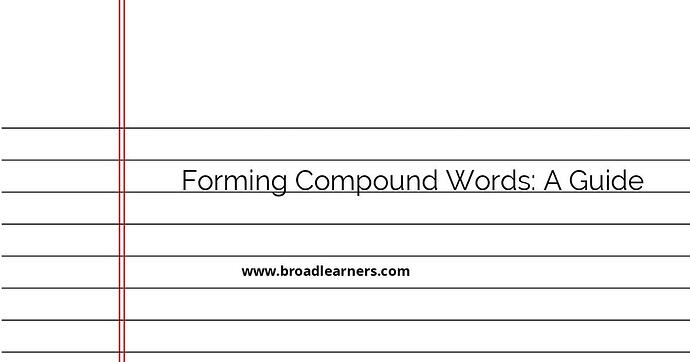Understanding how to form compound words can greatly enhance your vocabulary and writing skills. Compound words are two or more words that are joined together to create a new word with a distinct meaning. Knowing how to correctly form compound words will help you communicate more effectively and avoid common mistakes. In this guide, we will explore the rules and examples of forming compound words:
- Closed Compounds:
- Examples:
- keyboard
- sunflower
- classroom
- Definition: These compound words are written as a single word without any spaces or hyphens between the words. The two words are combined to create a new word with a unified meaning.
- Examples:
- Open Compounds:
- Examples:
- post office
- full moon
- high school
- Definition: These compound words are written as separate words with a space between them. Although they function as a single concept, each part retains its individual identity.
- Examples:
- Hyphenated Compounds:
- Examples:
- mother-in-law
- well-being
- self-control
- Definition: These compound words are connected by hyphens between the words. They are used when the individual words are connected to form a single concept but might be confusing or difficult to read if written as a single word or as separate words.
- Examples:
Now let's delve into each type of compound word in more detail:
1. Closed Compounds:
Closed compounds, also known as solid compounds, are formed by joining two words together without any spaces or hyphens in between. This creates a new word with a distinct meaning that is different from the individual words.
Examples:
-
Keyboard: The combination of 'key' and 'board' creates a single word that refers to the primary input device of a computer.
-
Sunflower: This compound word combines 'sun' and 'flower' to describe a vibrant yellow flower that follows the sun's direction.
-
Classroom: 'Class' and 'room' come together to form a word representing a space where students receive instruction or attend classes.
2. Open Compounds:
Open compounds, also called spaced compounds, consist of two or more words written separately with spaces between them. While they function as a single entity, each part maintains its independent meaning.
Examples:
-
Post Office: 'Post' and 'office' are separate words indicating a facility where mail is processed and distributed.
-
Full Moon: This compound word consists of 'full' and 'moon,' denoting a phase of the moon when it appears fully illuminated.
-
High School: 'High' and 'school' are distinct words combined to describe an educational institution for older students.
3. Hyphenated Compounds:
Hyphenated compounds, as the name suggests, are compound words that are linked by hyphens. This is done to clarify the meaning or aid in pronunciation when the combination might be confusing otherwise.
Examples:
-
Mother-in-law: The hyphens in this compound word help differentiate that it refers to the mother of a person's spouse, not the person's own mother.
-
Well-being: This compound word uses a hyphen to connect 'well' and 'being,' highlighting the state of being comfortable, healthy, and happy.
-
Self-control: 'Self' and 'control' are linked by a hyphen to emphasize the ability to regulate one's actions or emotions.
By understanding the distinctions between closed compounds, open compounds, and hyphenated compounds, you can effectively utilize compound words in your writing and enhance your language proficiency.
Did I miss anything? Respond below
